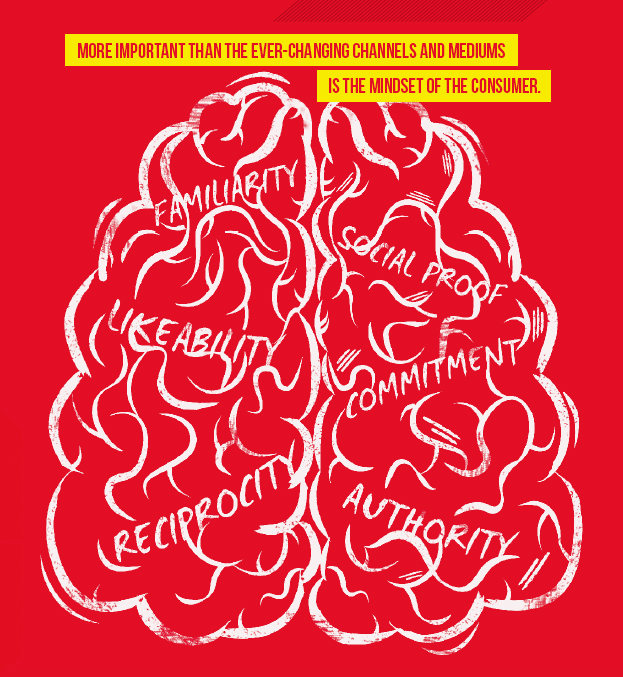Understanding the consumer’s mindset in order to generate brand loyalty.
Consumers have evolved, and will continue to evolve. Target audiences are ever-changing, with relevance playing an increasingly more important role in communication. The Internet and mobile technology have become the norm and an extension of our lives; behaviors and expectations have shifted to not just what, but when and where. We have gone from fax, phone and email to likes, comments and texts. Where marketing was previously about mass media channels, we must now think of everything as a channel.
Technology, social structures, brands, products and communication have all shifted significantly over the last 20 years, and so have consumers’ mindsets and expectations. The advertising industry has been focused on “integrated campaigns” – integrating different channels, such as social, digital and mobile with traditional and guerilla mediums. More important than the ever-changing channels and mediums is the mindset of the consumer. As millennials increase in their purchase power, as marketers we must understand their expectations and not only meet but exceed.
In order to fully understand which channels and messages should be crafted, we must first understand the new consumer mindset.
Six Integrated Mindsets
Familiarity
Building from the old-school goal of “awareness”, the expectation has shifted from just recall to a more personal connection: familiarity. The more times a consumer sees your message, the better. But the more they connect with the message, the more recall turns into caring for the product or brand.
Reciprocity
Beyond just telling consumers what they should feel or want, we should show them why they should purchase and interact with our brand. Brands, such as Toms, have capitalized on this mindset in an honest and authentic way – the philosophy of give, give, get. This doesn’t have to mean giving them discounts or coupons; it could be educational content like recipes or savings tips. The more you give utility and value, the more you will get from consumers.
Commitment
In the past, it was all about the “sale” and that first moment of truth – where a consumer is standing in the store aisle selecting which product or brand to purchase. Now there are many levels of commitment, from small pledges and comments to large commitments like an actual purchase. Each combination of these commitments builds that trust and fosters the relationship. The more people feel they have made a commitment to a brand, the more they feel obligated to fulfill their end of the agreement.
Social Proof
People trust people, not brands. Previously, it was all about expert reviews. Now, we as consumers look to other consumers for honest comments and reviews of the products and services we consume. Amazon has exploded with reviews and referrals based on this very mindset. We trust our friends, family and other consumers. Social proof is an endorsement. Activating advocates is imperative to solidify our credibility.
Likability
Fear tactics have been used successfully, but consumers want to like brands. They want you to be engaging, positive and helpful. For example, Dove focusing on self-esteem creates intense connection with the brand in a positive and engaging way. Consumers like the brand for the approach, and they not only recall messages and advertisements, they engage and share.
Authority
As the Internet has opened our world to real-time reports of anything and everything, building trust and credibility has become difficult for some brands. Creating authority in your industry requires transparency and education. Explaining what is important, why it is important and allowing consumers to see it unfold will build your brand’s authority, but, more importantly, it will build trust with your loyal consumers.
We must take from our past of reach, frequency and controlled messages and evolve. We must build relationships with our consumers – relationships based on generating interest, discovery and engagement. As we set up integrated campaigns, we must exceed these new expectations. If we keep these mindsets as objectives, we can truly connect with our consumers and convert them to brand advocates. Activate and facilitate conversations, slowly building lasting relationships that are independent of channels, campaigns and messages.
The 6 Integrated Mindsets are referenced in Dr. Robert Cialdini’s book “Influence: The Psychology of Persuasion”.



